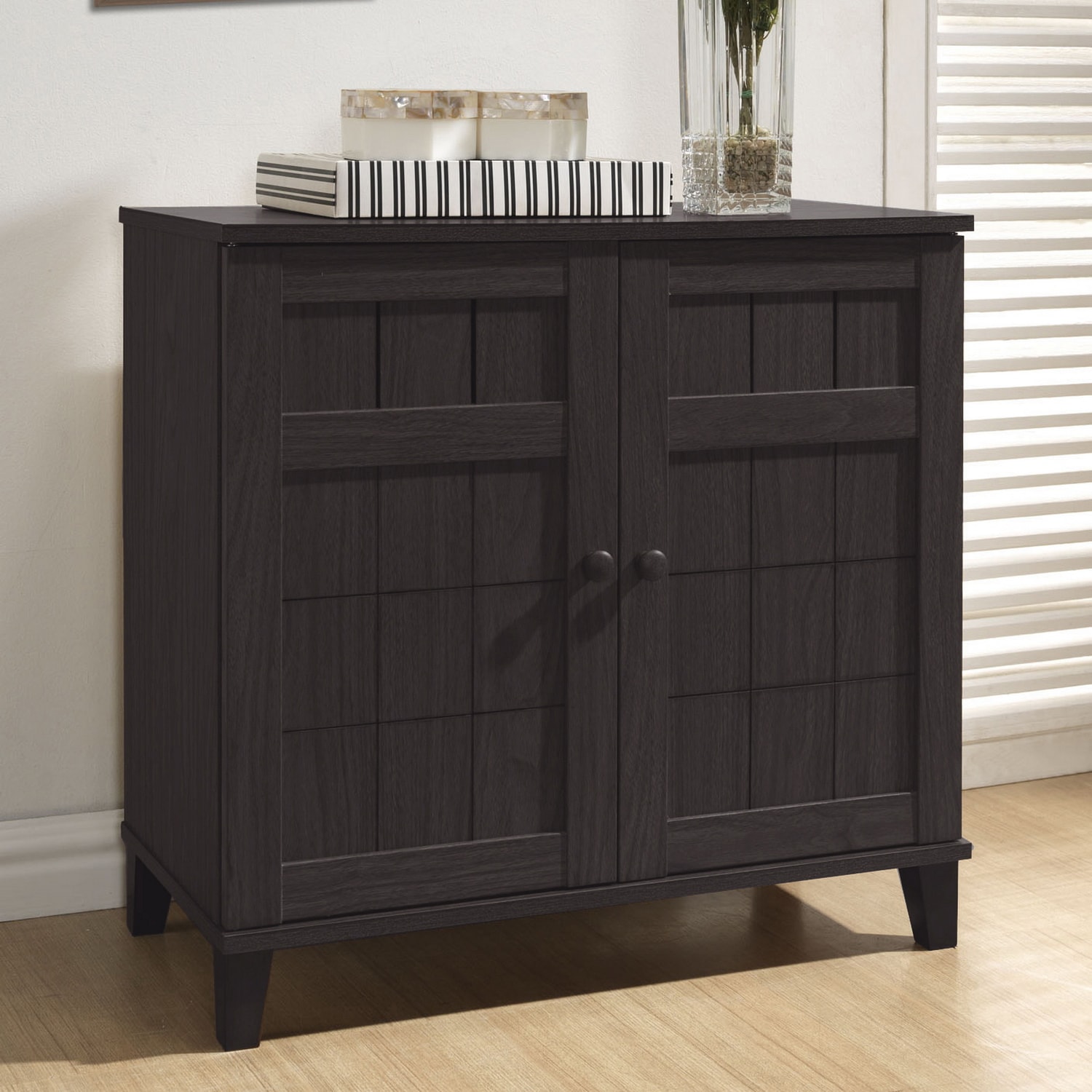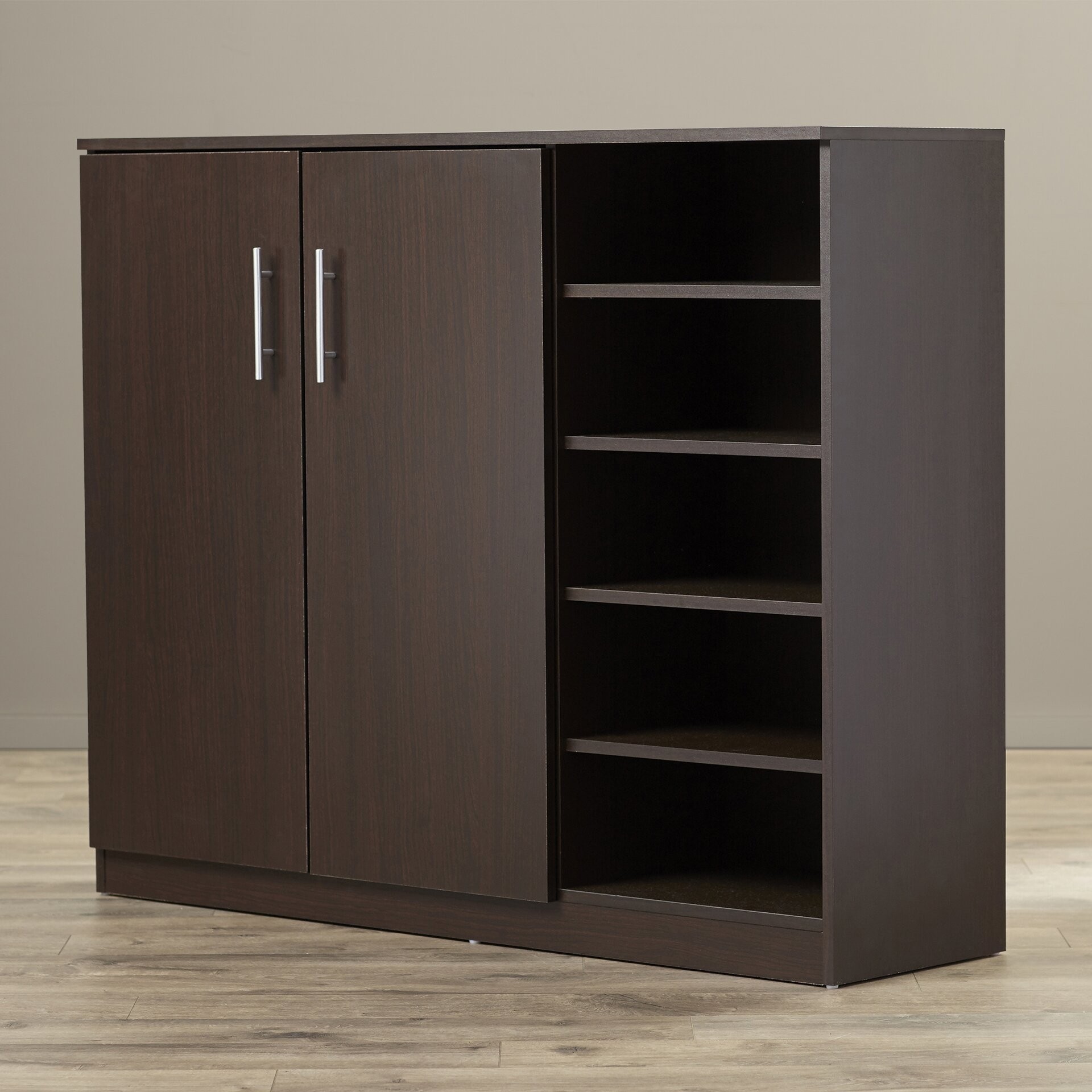Design Considerations for Low Height Shoe Cabinets

Designing a low-profile shoe cabinet for a small space requires careful consideration of both functionality and aesthetics. The goal is to maximize storage capacity without overwhelming the room or sacrificing style. This involves thoughtful choices regarding dimensions, materials, and internal organization.
Ideal Dimensions and Features for Small Spaces
For small spaces, an ideal low height shoe cabinet should prioritize maximizing vertical space while maintaining a slim footprint. A depth of 12-14 inches is generally sufficient to accommodate most adult shoes, while a height of 18-24 inches keeps it low-profile and prevents it from dominating the room. The length can be adjusted to suit the available space and the number of shoes to be stored. Incorporating features like adjustable shelves allows for flexibility in accommodating different shoe heights and sizes. A clean, minimalist design, perhaps with sleek handles or no handles at all, will contribute to a less cluttered feel. Consider adding a mirror to the door to further enhance the space’s functionality and visual appeal, turning a practical storage solution into a stylish element.
Material Comparison: Wood, Metal, and Plastic
The choice of material significantly impacts the shoe cabinet’s durability, aesthetics, and cost. Wood offers a classic, warm aesthetic and good durability, but it tends to be more expensive than other options and requires regular maintenance to prevent damage from moisture. Metal, particularly steel, is highly durable and relatively easy to clean, offering a modern, industrial look. However, metal can be more prone to dents and scratches, and its cold aesthetic may not suit all interior styles. Plastic is the most affordable option, lightweight, and easy to clean, but it generally lacks the durability and aesthetic appeal of wood or metal, and may not be as resistant to scratches or damage.
Design Incorporating Unique Storage Solutions
This design envisions a low-height shoe cabinet (36 inches wide x 14 inches deep x 20 inches high) constructed from light oak wood for a warm and inviting aesthetic. It features a combination of open shelving and pull-out drawers for optimized storage. The top section consists of two open shelves (each 17 inches wide x 12 inches deep x 8 inches high) for easy access to frequently worn shoes. The bottom section incorporates two pull-out drawers (each 17 inches wide x 12 inches deep x 6 inches high) for storing less frequently used shoes or accessories. The drawers would utilize smooth-gliding hardware for easy access. The cabinet would sit on four small, sturdy legs, offering a slight elevation for easier cleaning.
| Compartment | Width (inches) | Depth (inches) | Height (inches) |
|---|---|---|---|
| Top Shelf 1 | 17 | 12 | 8 |
| Top Shelf 2 | 17 | 12 | 8 |
| Bottom Drawer 1 | 17 | 12 | 6 |
| Bottom Drawer 2 | 17 | 12 | 6 |
Functionality and Practical Applications of Low Height Shoe Cabinets

Low-profile shoe storage offers a surprisingly versatile solution for many homes, providing practical benefits and aesthetic advantages often overlooked in favor of taller, more traditional cabinets. Their compact design makes them adaptable to various spaces and lifestyles, offering a functional and stylish addition to any interior.
Low height shoe cabinets, compared to their taller counterparts, present a unique set of advantages and disadvantages. The compact nature is a significant advantage, particularly in smaller apartments or entryways where floor space is at a premium. They also maintain a visually uncluttered aesthetic, preventing a sense of overwhelming bulkiness often associated with larger storage units. However, a disadvantage is the reduced storage capacity. While suitable for smaller households or those with a minimalist approach to footwear, larger families or avid shoe collectors might find them insufficient.
Suitability for Different Homes and Lifestyles
Low height shoe cabinets are particularly well-suited for homes with limited floor space, such as apartments, condos, or smaller houses. Their shallow depth makes them ideal for narrow hallways or entryways where a taller cabinet might feel cramped and obstructive. They’re also a great fit for minimalist or modern homes where clean lines and uncluttered spaces are prioritized. For individuals with a smaller shoe collection or those who prefer to keep their footwear organized and easily accessible, a low profile cabinet is a practical choice. Conversely, families with numerous shoes or those who frequently wear boots or other bulky footwear might find a taller cabinet more suitable for their needs.
Incorporating Low Height Shoe Cabinets into Various Interior Design Styles
A low height shoe cabinet can be seamlessly integrated into various design schemes. In a minimalist setting, a sleek, simple cabinet in a neutral color, perhaps made of light wood or matte white, would blend seamlessly with the clean lines and uncluttered aesthetic. Imagine a narrow, white cabinet positioned against a plain white wall, accented only by a small, minimalist plant placed on top. The visual impact is one of understated elegance and functional simplicity.
For a modern interior, a low cabinet with geometric lines and metallic accents could add a touch of sophistication. A dark wood cabinet with brushed brass handles, for example, placed beneath a modern mirror in a hallway, would create a stylish and functional focal point. The cabinet could be complemented by other modern elements, such as sleek lighting and abstract artwork.
In a more traditional setting, a low height shoe cabinet with ornate detailing and a richer wood finish would complement the overall aesthetic. A dark wood cabinet with carved detailing, placed in an entryway with a traditional rug and antique mirror, would add a touch of classic elegance. The overall impact is one of refined storage seamlessly integrated into the room’s existing character.
Optimal Storage Solutions for Different Shoe Types
Proper organization is key to maximizing the functionality of a low height shoe cabinet. Consider the following suggestions for optimal storage of various shoe types:
The following list details suggested storage methods for different types of shoes within a low height shoe cabinet:
- Boots: Store boots upright in designated compartments or use boot shapers to maintain their form. Consider using dividers to prevent them from toppling over.
- Heels: Utilize dividers or shallow drawers to keep heels from scratching each other. Storing them in their original boxes can also be effective.
- Sneakers: Sneakers can be stored horizontally or vertically depending on the cabinet’s design. Using shoe organizers or dividers can help maintain order and prevent stacking.
- Sandals and Flats: These can be stored horizontally in stacks or vertically in compartments. Again, dividers can help prevent damage.
- Slippers: Slippers can be stored in a dedicated shallow drawer or shelf, keeping them easily accessible and preventing them from getting lost amongst other shoes.
Manufacturing and Market Trends for Low Height Shoe Cabinets

The manufacturing and market landscape for low height shoe cabinets is dynamic, influenced by both sustainability concerns and evolving consumer preferences. Manufacturers are increasingly adopting eco-friendly practices to meet growing demand for environmentally responsible products, while design trends reflect a shift towards minimalist aesthetics and multifunctional furniture.
Sustainable Manufacturing Practices
Many manufacturers are embracing sustainable practices in the production of low height shoe cabinets. This includes utilizing recycled materials such as reclaimed wood or recycled plastic in cabinet construction. Energy-efficient production methods, such as using LED lighting in factories and optimizing machinery to reduce energy consumption, are also becoming more prevalent. Furthermore, some companies are focusing on sourcing wood from sustainably managed forests, ensuring responsible forestry practices and reducing deforestation. The use of low-VOC (volatile organic compound) paints and finishes minimizes harmful emissions during the manufacturing process and contributes to better indoor air quality. These efforts aim to reduce the overall environmental impact of shoe cabinet production and appeal to environmentally conscious consumers.
Current Market Trends and Design Features
Current market trends reveal a strong preference for minimalist and space-saving designs in low height shoe cabinets. Sleek, modern aesthetics with clean lines and neutral color palettes are highly sought after. Multifunctional designs, such as cabinets with integrated seating or hidden storage compartments, are gaining popularity, reflecting the increasing demand for versatile and efficient furniture solutions for smaller living spaces. The use of high-quality materials, such as solid wood or durable laminates, is also a significant trend, reflecting a focus on both aesthetics and longevity. Furthermore, consumers are increasingly interested in customizable options, allowing them to personalize their shoe cabinets to match their individual needs and style preferences. For example, modular designs that can be easily expanded or reconfigured are becoming increasingly popular.
Rewritten Article: Low Height Shoe Cabinets: A Comprehensive Guide
Low height shoe cabinets offer a practical and stylish solution for organizing footwear and maximizing space in any home. Their compact design makes them ideal for entryways, hallways, or even bedrooms where floor space is limited. A variety of materials are used in their construction, ranging from durable wood and sturdy laminates to sleek metals and sophisticated glass. The choice of material often depends on personal preference, budget, and desired aesthetic. Consider the overall style of your home when selecting a shoe cabinet; a rustic wooden cabinet might complement a farmhouse aesthetic, while a sleek, minimalist design would suit a contemporary space. Practical features to consider include the number of shelves, the depth of the compartments (to accommodate various shoe sizes), and the presence of additional storage options like drawers or cubbies. Proper ventilation is crucial to prevent musty odors, so opt for a cabinet with adequate air circulation. Regular cleaning will help maintain the cabinet’s appearance and hygiene. Finally, measuring your available space before purchasing is essential to ensure a proper fit. Careful consideration of these factors will help you select the perfect low height shoe cabinet to meet your storage needs and enhance your home’s style.
